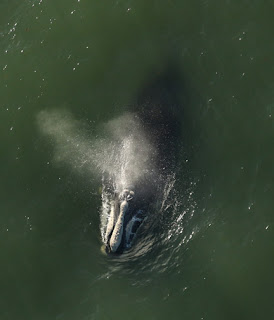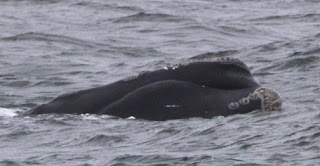PLAN B
Considering appropriate Covid precautions, the planned January 3 gathering at the Whitney Lab auditorium will not be held. Instead, we will follow the protocols used during the 2021 season. To participate this year, we require everyone to have their shots including booster. If you feel unwell in any way, please stay home until cleared with a test. Wear a high-quality mask. Limit group sizes. Observe distancing. This is challenging. But we did it last year, and we can do it again. Surveys will begin on Tuesday, January 4 at 8:00 AM.
To offset some of these limitations, we will communicate regularly via email and this blog. We are monitoring Covid closely. If possible, we will hold the mid-year meeting on February 5 and the End-of-year meeting on March 12. Mark your calendar.
Snow Cone
During the 2020 season, Female Catalog #3560, Snow Cone, and her calf were sighted on nine occasions. They were sighted on January 1, 2020 (the “New Year’s whales”) off Ormond, were seen in the fog on February 12 off Gamble Rogers State Park, and reported headed north off North Carolina on April 6.
Her popularity was enhanced when, following on a volunteer sighting on 8 March, she/they became a focus of a right whale documentary being filmed for the Canadian Broadcasting Network (CBC). "Last of the Right Whales."
However, there were some dark clouds. Scars and peduncle marks suggested several earlier entanglements for #3560. Then on the morning of 25 June 2020, a floating whale carcass was sighted off New Jersey. The dead whale was identified as the male calf of #3560. It is uncertain whether or not whales feel pain and emotions, but #3560 may have experienced both.
Then, in March 2021, Snow Cone was sighted entangled off Cape Cod. Some line was removed but the entanglement was considered serious. In May 2021, Snow Cone was reported as entangled in the Gulf of St. Lawrence.
Then, on December 2, she and a calf (#2) were sighted off Cumberland Island, Georgia. Remarkable. Traveling 1,300 miles while pregnant and entangled. Snow Cone still has rope attached to her mouth and trailing from her body (image below). She is challenged―raising and nursing a calf while entangled. Please be on the lookout.
Snow Cone, #3560, entangled and with calf, 6 December 2021, off Florida.
(Image: FWC, permit #20556)
Report Posted
The 2020–21 report has been posted to www.aswh.org. See the items listed at the lower left on the home page. Select “Right whale report ’21.”








